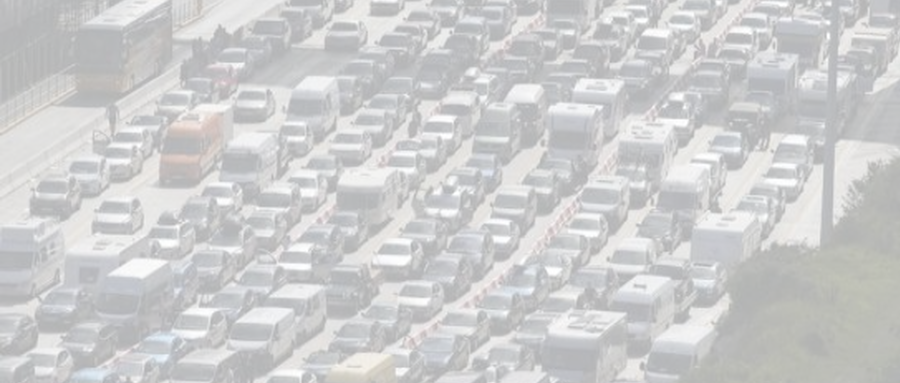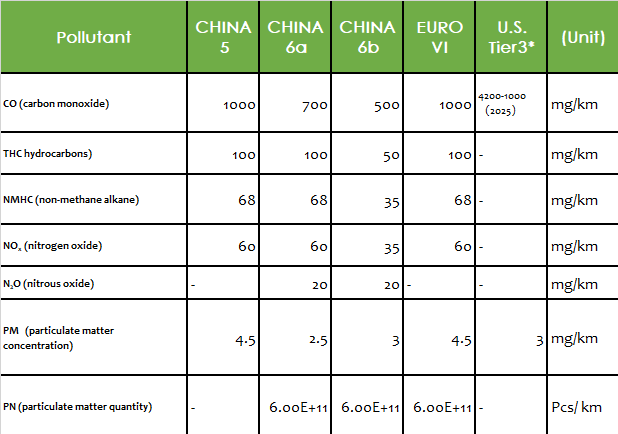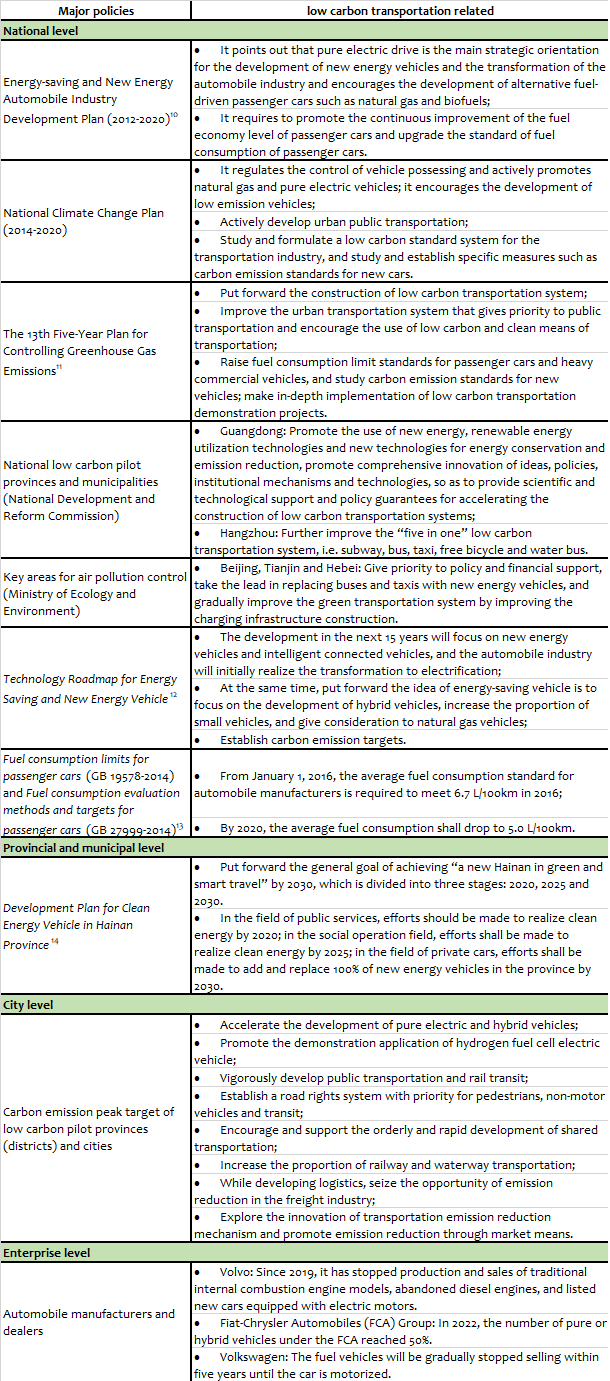

The transport sector involves both traditional pollutant emissions and greenhouse gas emissions, which makes it difficult to solve the challenge of air pollution and climate change at the same time. Although the two types pollutants are of the same source, their impacts and formation processes are quite different, which leads to the fact that the policies for the two are often separated when they are formulated, but actually they are partially overlapped at the implementation level, resulting in unsatisfactory policy implementation effect. This article will review the development of China's low-emission transportation policies from the perspectives of pollutant control and low carbon transportation policies, discuss specific issues and give policy recommendations.
Review of Transport Pollution Control Policy
In early 2013, Northern China encountered continuous smoggy days. In autumn 2013, the State Council promulgated the Air Pollution Prevention Action Plan1, which put forward specific feasible suggestions on transportation, mainly focusing on traffic management, oil quality, scrapping of high-emission vehicles, environmental protection management of motor vehicles, promotion of new energy vehicles, etc. In the same year, some laws and regulations such as the Law of the People's Republic of China on the Prevention and Control of Atmospheric Pollution and the Environmental Protection Law of the People's Republic of China were revised one after another, and air pollution policies at the regional, provincial and municipal levels were also promulgated one after another. As a basic law in the field of air pollution prevention and control, the Law on the Prevention and Control of Atmospheric Pollution was promulgated in 1987 and revised in 2000. The new edition (2016) 2 includes management of emission limits to control the vehicular pollutants. In terms of energy conservation, public transportation and driving behavior, the law is only at the level of encouragement and advocacy.
Motor vehicle emission limit
At present, the motor vehicle emission standard widely implemented in the whole country is Light Vehicle Emission Limits and Measurement Methods (CHINA 5) (GB 18352.5-2013), which is abbreviated as "CHINA 5 Standard". According to the relevant provisions of the Law of the People's Republic of China on the Prevention and Control of Atmospheric Pollution, more developed regions such as Guangdong Province have already implemented the “CHINA 5” in advance from 20153.
At the end of 2016, the Ministry of Ecology and Environment issued Limits and Measurement Methods for Emissions from Light-duty Vehicles (CHINA 6) (GB18352.6-2016). The CHINA 6 standard will be implemented on July 1, 2020. The limits in this standard are far higher than those in EURO 6 emission standard and the Tier3 Standard in the United States, which is by far the strictest standard in the world for motor vehicle emission standards. At present, many provinces and cities across the country have begun to implement the "CHINA 6 standard". Compared with the “CHINA 5 standard”, the CHINA 6 standard has added the nitrous oxide limit requirement.
Table 1: Comparison of emission standards for motor vehicle pollutants

*Tier3 emission standard specifies the total amount of NMOG (Non-methane organic gas) and NOx and replaces them in seven levels.
Fuel standard
The 2013 Air Pollution Prevention Action Plan proposed to improve fuel quality. Strive to supply automobile gasoline conforming to the "CHINA 4" standard nationwide by the end of 2013, and supply automobile diesel conforming to the "CHINA 4" standard nationwide by the end of 2014 and supply automobile gasoline and diesel conforming to “CHINA 5” standard nationwide by the end of 2017."
In June 2018, the State Council's Notice on Issuing a Three-Year Action Plan on Air pollution Control required that "from January 1, 2019, supply the automobile gasoline and diesel conforming to 'CHINA 6 Standard' nationwide and stop selling gasoline and diesel below CHINA 6 Standard …”4. Compared with “CHINA 5” oil products, “CHINA 6” gasoline/diesel is mainly reduced in the content of olefin, aromatic hydrocarbon, benzene, etc. in automobile gasoline; in addition, polycyclic aromatic hydrocarbons in the index of vehicle diesel oil is reduced but the quantitative index requirement of total pollutant content is added, which is in line with the current European Union standard level of vehicle oil products, and even individual indexes exceed the European Union standard.
Traffic demand management: taking both administrative and economic measures
In addition to improving vehicle exhaust emission standards and upgrading the quality of oil products, there are also many policies and measures in traffic demand management that can reduce pollutant emissions. For example, traffic restrictions and license plates number restrictions are implemented in some areas to ease traffic congestion, which are currently common in large cities in China. Traffic demand is reduced by restricting the purchase and use of cars.
In addition, the emission standards mentioned above can also reduce the intensity of pollution emission by restricting and banning the use of vehicles. The CHINA 6 standard for motor vehicles is for new cars, and the impact on purchased and used cars is based on whether and how the regions implement the restrictions. However, after the promulgation of the CHINA 6 standard, in the future, more restriction will be imposed on vehicles that are lower than the standard. Some cities have even introduced measures to prohibit “CHINA 4” vehicles from entering the urban areas. For example, in Taiyuan, Shanxi, the latest control measures clearly specify that diesel trucks under CHINA 4 standard (inclusive) are prohibited from passing the key roads all day5. Therefore, it is another measure to reduce pollutant emission intensity due to the standard upgrade. As for how to implement it, the actual situation in various regions should be considered, and the policies of restriction and prohibition should be formulated.
Summary: China's pollution control mainly relies on legislation to guide the vehicle exhaust emission standards and the upgrading of oil standards. Currently, the CHINA 6 standard that have been implemented in some provinces and cities are at the international advanced level. Reducing pollutant emissions through the transition to strict emission standards and oil quality standards is the only way to control the total amount of pollutant emissions, the main reason is that the emission amount is very large due to huge number of motor vehicles in China even if the CHINA 6 standard is fully implemented across China. In addition, relevant policies such as encouraging the use of public transportation and new energy vehicles, total vehicle number control, and eco-friendly driving also play a role in reducing pollutant emissions, but the objectives of these policies are not completely focused on controlling pollutants or the driving force is very small, and are not analyzed as a key point.
Low carbon transportation policies
Review of low carbon transportation policy
With regard to low carbon transportation, the national policy can refer to the National Climate Change Plan (2014-2020),6 in which the low carbon development of transportation mainly focuses on the regulation of the total number of motor vehicles, fuel substitution, development of public transportation, low carbon standard system, and so on (Table 2). It is worth pointing out that the plan proposes to study and establish carbon emission standards for new vehicles and encourages the development of low-emission vehicles.
Other policies at the national level include low carbon provinces and cities and key cities for air pollution prevention and control, which are also policies that directly or indirectly promote the reduction of carbon emissions. At present, the national ministries and commissions concerned with low carbon transportation are mainly the National Development and Reform Commission and the Ministry of Ecology and Environment. The Ministry of Transport has launched the pilot city of low carbon transportation in 2012, but did not continue after two batches of pilots.
From a technical point of view, there is a road map for the technology development of energy saving and new energy vehicle, which provides a detailed technical path for emission reduction7. In terms of national standards, the standard Fuel consumption limits for passenger cars actually indirectly restricts CO2 emissions. At that time, the CO2 emission limit will be around 120 g-CO2/km, which is still a certain gap from the new car emission limit8 of 95 g-CO2/km introduced by the EU from 2020. At present, the CHINA 5 standard (2021-2025) is in the process of soliciting opinions9. The target is to reach an average fuel consumption of 4.0 L/100km for new passenger cars by 2025, when this standard is also close to the average level set by developed countries in the world.
Table 2: China’s low carbon transportation policies in recent years

Suggestions on current low carbon transportation policy
In the perspective of the national macro policy level, the current low carbon transportation policy has not been attached great importance to, and it is at the level of planning and implementation of the work plan. The set goals are mainly concentrated in the field of operational transportation, and there is still a lack of effective control policies for the fastest growing non-operational areas. The specific problems we have observed, and suggestions are as follows:
Issuing special policies of transportation department to deal with climate change
Develop and organize the implementation of special plans or special action plans for the transportation industry to deal with climate change, and subdivide them into sub-sectors such as roads, railways, water transportation and aviation, according to China's National Climate Change Programme and China’s National Plan on Climate Change (2014-2020) and other documents.
Expanding the target range of transportation emission peak
Although some cities have proposed to reach the peak of traffic carbon emissions at the city level, most cities have not set goals, so it is necessary to further expand the pilot of low carbon cities to increase the number and scale of cities committed to reach the peak, and expand it to the scope of province.
Strengthening the low carbon policy and standard system for transportation
Vehicle carbon emission standards and their corresponding carbon emission reductions shall be linked to Nationally Determined Contribution (NDC) at the national macro level; just like the management of air pollutants, the specific air quality level corresponds to the total emission limit of pollutants in various industries, and the emission limit standards and corresponding policies are formulated accordingly.
Making the low carbon technical route clearer
Increasing the proportion of low carbon fuels is an issue to be considered in different low carbon paths. How to reasonably evaluate the economy and feasibility of different low carbon fuels such as LNG (liquefied natural gas), CNG (compressed natural gas), electric power, hydrogen fuel and among others; at present, there are still large arbitrariness and industry judgment affecting the selection of reasonable technical routes.
Coordinating economic development and social equity
Most urban transportation policies focus on the goal of achieving a low carbon city, while there are no corresponding supporting policies for achieving more macro goals such as sustainable and livable cities, such as promoting social and economic development and social equity on the basis of achieving a low carbon city. Moreover, the fairness of travel is not considered enough.
Discussions on “no fuel vehicles” should be opened
At present, only Hainan Province has issued a policy on banning the sale of fuel vehicles. The European Union, the United States and other places have already expressed their positions on the “no fuel vehicles” policy. China’s future development plan and no-sale schedule for fuel vehicles should also be discussed on a larger scale, such as at the provincial and even national levels.
National low carbon policy needs to increase synergy
The Ministry of Housing and Urban-Rural Development and the Ministry of Science and Technology have launched a national smart city pilot. Smart city construction can promote the development of low carbon transportation, but the specific policies may overlap with the national low carbon pilot provinces and cities led by the National Development and Reform Commission. Therefore, the policies for low carbon transportation adopted by different ministries should be properly coordinated in the process of formulation and implementation to avoid the policy effect to be reduced.
Lack of carbon pricing
The small and disproportionate carbon emissions due to the mobile source characteristics of the transport sector make it challenging for market-based, cost-effective policy instruments such as carbon credit trading to control the carbon emissions of the transport sector. At present, Singapore has already implemented a carbon tax in all sectors, while China’s choice of carbon pricing for the transport sector is still in discussion, and those who support the implementation of the carbon tax think it is simpler and easier.
Conclusion
Due to the homology between traditional pollutants and greenhouse gas emissions in the transport sector, many transportation low emission policies overlap. In general, there are four ways to achieve emission reduction in the transport sector: controlling the level of traffic activities, optimizing the composition of transportation modes, improving fuel efficiency and promoting clean energy applications.15 At present, clean transportation and low carbon development in China still rely on fuel substitution and travel modal shift to reduce the consumption and reduction of fossil fuels, thus reducing the emission of traditional pollutants and greenhouse gases. A common problem faced by China’s urban transport sector in reducing emissions is that the reductions in emissions and efficiency of existing technology measures to improve vehicle energy efficiency are not sufficient to offset the increase in emissions.
After the China-US trade war, China’s preference for key consumer goods, such as automobiles16, “it is strictly forbidden to introduce new regulations on automobile purchase restriction everywhere, and local governments that have implemented automobile purchase restriction should speed up the shift from purchase restriction to use guidance according to the control effect of urban traffic congestion, pollution control and traffic demand...”, which brings uncertainty to the development of low emission transportation in the future. Under the current economic situation, more similar problems may be faced in the future. Therefore, it is one of the challenges of future transportation policies to replace administrative measures such as restriction of travel and purchase with market measures, and to manage the level of transportation activities and balance the development of the automobile industry through market-based mechanisms.
Developing low-emission transportation should be a slogan for the transport sector in the future. Finally, it is suggested that when formulating the low-emission transportation policy, not only the problems at the solution level should be discussed, but also the public health factors should be taken into account, and how to improve public awareness on green travel and change the existing driving behavior should be further discussed.
References
1.Air Pollution Prevention Action Plan, the State Council. Link : http://www.gov.cn/zwgk/2013-09/12/content_2486773.htm
2. Law of the People's Republic of China on the Prevention and Control of Atmospheric Pollution, the Ministry of Ecology and Environment. Link :http://zfs.mee.gov.cn/fl/201811/t20181113_673567.shtml
3.Notice of the Guangdong Environmental Protection Bureau on the Advance Implementation of the CHINA 5 vehicle emission standard of air pollutants. Link :http://www.gdep.gov.cn/zwxx_1/zfgw/shbtwj/201502/t20150215_199209.html
4.Notice of the State Council on Issuing a Three-Year Action Plan on Air pollution Control Guo Fa [2018] No.22. Link : http://www.gov.cn/zhengce/content/2018-07/03/content_5303158.htm
5.Taiyuan released control measures for truck traffic in urban areas, People's Network. Link : http://sx.people.com.cn/n2/2019/0320/c189132-32755667.html
6.National Climate Change Plan (2014-2020), 2014, National Development and Reform Commission. Link :http://www.ndrc.gov.cn/gzdt/201411/W020141104591413713551.pdf
7.Technology Roadmap for Energy Saving and New Energy Vehicle, 2019, compiled by Strategy Advisory Committee of the Technology Roadmap for Energy Saving and New Energy Vehicle, Society of Automotive Engineering of China.
8.Reducing CO2 emissions from passenger cars, European Commission. Link: https://ec.europa.eu/clima/policies/transport/vehicles/cars_en
9.Letter of Solicitation for Comments on Compulsory National Standards for Automobile fuel consumption limits for passenger cars and Fuel consumption evaluation methods and targets for passenger cars, 2019. Link :http://www.catarc.org.cn/StandardRevision/detail/1247.html
10.Notice of the State Council on Issuing Energy-saving and New Energy Automobile Industry Development Plan (2012-2020), 2012, the State Council. Link : http://www.gov.cn/zwgk/2012-07/09/content_2179032.htm
11. Notice of the State Council on Issuing the "13th Five-Year Plan" to Control Greenhouse Gas Emissions, Guo Fa [2016] No.61. Link :http://www.gov.cn/zhengce/content/2016-11/04/content_5128619.htm
12.Technology Roadmap for Energy Saving and New Energy Vehicle, Strategy Advisory Committee of the Technology Roadmap for Energy Saving and New Energy Vehicle, edited by Society of Automotive Engineering of China, 2017, China Machine Press.
13.The fourth stage standard of fuel consumption for passenger cars was issued, 2015, the Ministry of Industry and Information Technology. Link :http://www.miit.gov.cn/newweb/n1146285/n1146352/n3054355/n3057585/n3057592/c3616946/content.html
14.Development Plan for Clean Energy Vehicle in Hainan Province, 2019, Hainan Provincial Government. Link :http://www.hainan.gov.cn/hainan/szfxwfbh/201903/1c7d9c22de134a0194f25a92fedaca8d.shtml
15.Research on the Transportation Development of Low Carbon City in China, Yang Baolu, 2017, China Environmental Science Press
16.Implementation Plan of Promoting Renewal and Upgrading of Key Consumer Goods and Facilitating Recycling of Resources (2019-2020), 2019, National Development and Reform Commission of People’s Republic of China. Link :http://www.ndrc.gov.cn/gzdt/201906/W020190606539195149373.pdf




